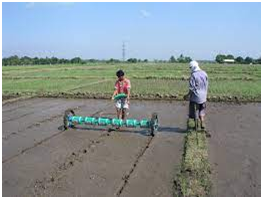Direct-Seeding Method:
News: The direct-seeding technique is being used by farmers in the top rice-producing states as a response to labour shortages and delayed rains.
The “broadcasting seed technique,” commonly referred to as direct seeded rice (DSR), is a water-efficient way to plant paddy.
Using this technique, there is no need for transplantation or nursery preparation because seeds are drilled directly into the fields.
When using drum seeders, just two workers are needed, as opposed to 25–30 workers when using conventional methods, to plant seeds on one acre.
This lowers labour expenses greatly and lessens the load on farmers.
Farmers can shorten the crop cycle by about 30 days by doing away with nursery cultivation.
As a result, they can begin the rabi season early and stay dry while harvesting is being done.
Since water logging doesn’t happen until after a month with the direct-seeding approach, the water consumption is reduced by about 15%. This is especially useful in regions with delayed rainfall.
The yield is one to two quintals per acre higher following this procedure compared to puddled transplanted rice, according to the findings of research experiments and farmers’ field surveys.




